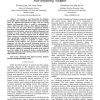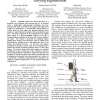69 search results - page 12 / 14 » Gaits and Gait Transitions for Legged Robots |
IROS
2006
IEEE
14 years 1 months ago
2006
IEEE
- We propose a novel framework for imitation learning that helps a humanoid robot achieve its goal of learning. There are apparent discrepancies in shapes and sizes among humans an...
IJCNN
2006
IEEE
14 years 1 months ago
2006
IEEE
— Biped robots based on the concept of (passive) dynamic walking are far simpler than the traditional fullycontrolled walking robots, while achieving a more natural gait and cons...
ISRR
2001
Springer
13 years 12 months ago
2001
Springer
We demonstrate an adaptation strategy for adjusting the stride period in a hexapedal running robot. The robot is inspired by discoveries about the self-stabilizing properties of i...
ICRA
2010
IEEE
13 years 6 months ago
2010
IEEE
—In many robotics applications, knowing the material properties around a robot is often critical for the robot’s successful performance. For example, in mobility, knowledge abo...
IROS
2006
IEEE
14 years 1 months ago
2006
IEEE
- Metabolic studies have shown that there is a metabolic cost associated with carrying load [1]. In previous work, a lightweight, underactuated exoskeleton has been described that ...


